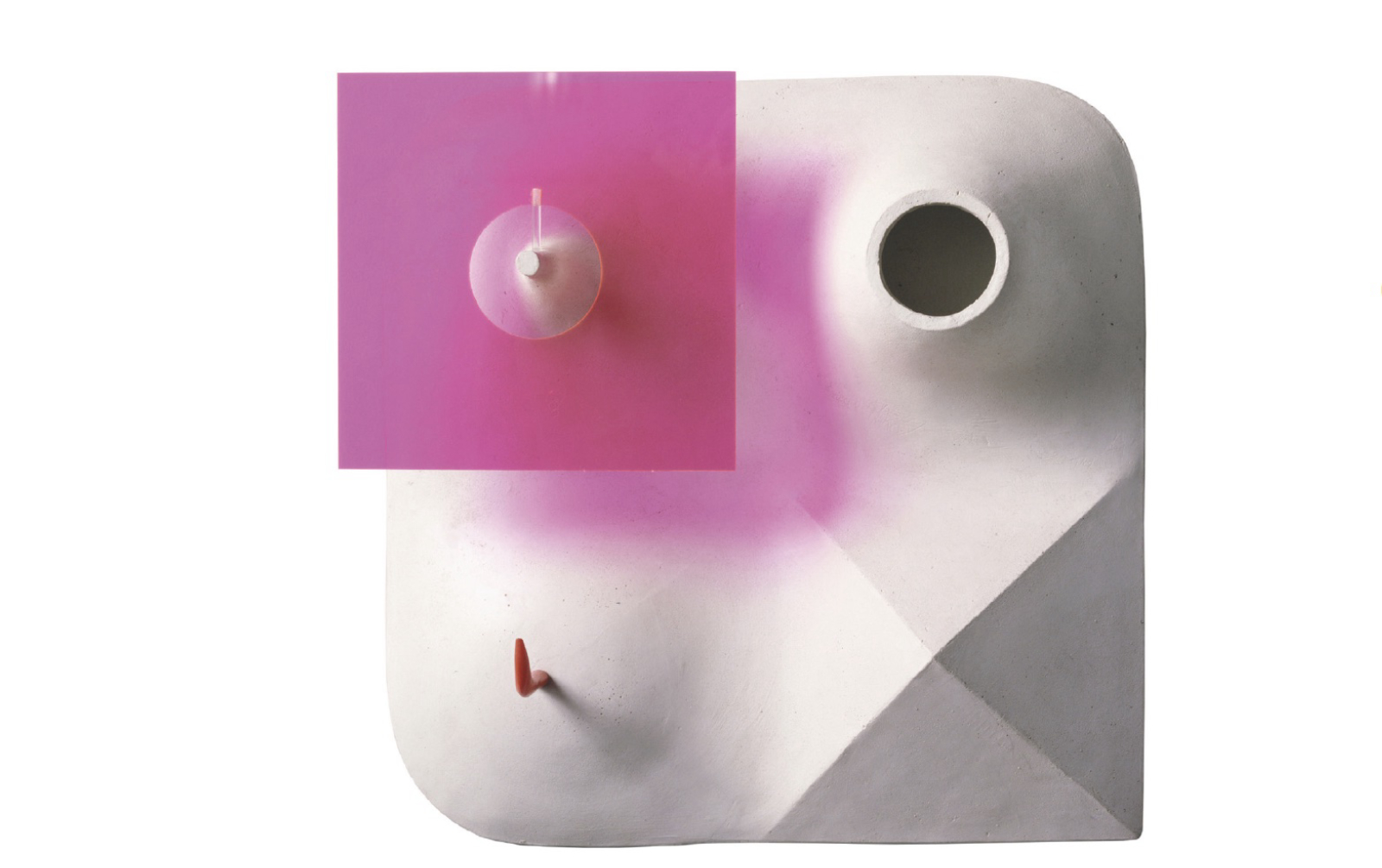"The memory of Arizona was like that of the moon... a moonscape of the mind...Not given the actual space of freedom, one makes its equivalent -- an illusion within the confines of a room or a box -- where imagination may roam, to the further limits of possibility and to the moon and beyond."
Isamu Noguchi, A Sculptor's World
In May 1942, Isamu Noguchi voluntarily entered the Poston Internment Center, one of ten euphemistically-named ‘Relocation Centers’ established by Executive Order 9066. In response to his incarceration experiences in the Arizona desert, the sculptor made “My Arizona,” one of a series of abstract lunar landscapes, after his release. In the work, a hot pink Plexiglas plane hovers over a white desert landscape. The fluorescent cast from the plexiglass glows hotly over the abstracted forms of conical mounds and valleys below. The sculpture is squared at the edges, forming a boundary that confines within it the landscape and all that lives there.
As is evident in “My Arizona”, the connections between objects and their creators’ experiences––including the physical places and broader cultural landscapes in which they were produced––underpin their social power. How did the objects designed by Japanese American survivors after incarceration give expression to central conflicts of identity, and help their makers to navigate between hopelessness and action? What new meanings did these objects and their makers take on as they found their places in postwar American life? Can a house, a gas station, a garden, a church, or a teacup help us think in new ways about the impact of incarceration on Japanese Americans and their communities even years later? Or about the capacity of material objects and practices to shape social identities? To carry or transform collective memory?
This conference will bring together scholars from a range of humanities and art/design fields to explore the hidden legacies of internment––“hidden,” that is, in plain sight, in the rich landscapes of mid-century American design and culture. Scheduled to coincide with the 80th anniversary of the internment period, the conference will advance the work of compiling an edited volume of artifact-focused essays on this subject. We seek contributors who will join us in pursuit of new ways of thinking about Japanese American incareration experiences and the impact on postwar creative work by considering a single artifact in its contexts of creation, use, and broader social meanings. Survivors of internment created some of the architectural, artistic and design hallmarks of mid-century cultural life, embraced as “American,” “democratic,” and definitively “modern” in all senses. Yet their authors’ experiences as citizen-detainees were rarely acknowledged in that post-war world, even by the survivors themselves.
That amnesia continues. Much of the broader public has also “forgotten” much of this history, despite ample documentation of internment policies and practices, an official apology by the U.S. government, and the opening of the camps to visitors. So have many scholars, despite ongoing efforts to decolonize design and, more broadly, to reckon with racial violence and white supremacy. The project is part of a larger research and archival initiative based at Washington University in St. Louis, where the conference will be held. WashU was one of a handful of institutions that accepted Japanese Americans as students during the internment period. About thirty attended the university, and four of them––Gyo Obata, Richard Henmi, George Matsumoto, and Fred Toguchi––went on to be architects of note. Their work and experiences will be featured in an on-site exhibition during the conference.
Call for Papers:
Interested authors are invited to develop an abstract for an object-focused essay (c. 5000 words) to be presented at the conference. The essay would then be considered for inclusion in an edited volume. Essays should consider localized “artifactual” details such as the genesis, use, form, and materiality of the object. Beyond that, they might consider any number of other contextual factors, starting with the foundational facts and psychological impacts of incarceration, and extending to the personal/family experiences of the designers, their specific career arcs, and the broader social and cultural worlds in which they did their work. Contributors are encouraged to develop creative approaches to reading their chosen objects, exploring their complex social meanings and potential as lieux de memoire. How might such objects be interpreted in relation to issues of inclusion, exclusion, and broader civic and social identity formation; or to memorializing and forgetting the war; or perhaps to advancing modernist design and planning agendas, including urban “renewal,” so often predicated on erasure of communities of color; or to consumer culture and suburbanization; or to “mid-century modern” as a signifier of elite design culture, or more recently, middlebrow nostalgia? This list is suggestive, not limiting; authors are welcome to identify other factors of interest.
Prospective contributors should send the following to editors by November 21, 2022:
- 350-word abstract for the proposed essay (word count exclusive of footnotes)
- CV
- short (100-word) biography
Please submit your abstracts to: kelleyv@wustl.edu
Timeline:
Deadline for proposals: November 21, 2022
Essay drafts due for initial review: March 15, 2023:
Colloquium: April 14-15, 2023, Washington University in St. Louis (NOTE: A stipend will be provided to help defray travel expenses; lodging will be covered by the university.) Essay revisions: Following the conference, a set of recommendations for the final round of edits will be provided, and a final submission date will be set in late fall, 2023.
Co-editors: Heidi Aronson Kolk, Kelley Van Dyck Murphy, and Lynnette Widder
